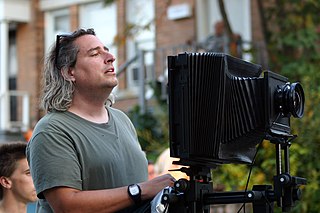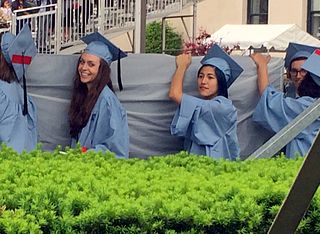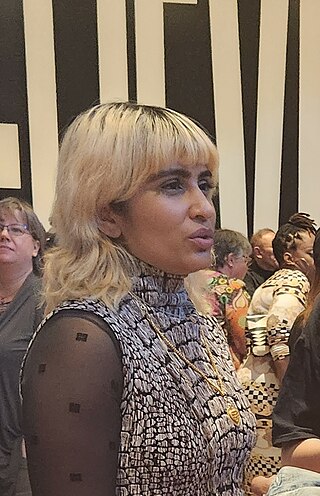
Performance art is an artwork or art exhibition created through actions executed by the artist or other participants. It may be witnessed live or through documentation, spontaneously developed or written, and is traditionally presented to a public in a fine art context in an interdisciplinary mode. Also known as artistic action, it has been developed through the years as a genre of its own in which art is presented live. It had an important and fundamental role in 20th century avant-garde art.

Gregory Crewdson is an American photographer. He photographs tableaux of American homes and neighborhoods.

Catherine Sue Opie is an American fine-art photographer and educator. She lives and works in Los Angeles, as a professor of photography at University of California at Los Angeles.

Eva Hesse was a German-born American sculptor known for her pioneering work in materials such as latex, fiberglass, and plastics. She is one of the artists who ushered in the postminimal art movement in the 1960s.
Sarah Sze is an American artist and professor of visual arts at Columbia University. She has exhibited internationally and her works are in the collections of several major museums. Sze's work explores the role of technology and information in contemporary life utilizing everyday materials. Drawing from Modernist traditions, Sze's work often represents objects caught in suspension.

Hannah Wilke was an American painter, sculptor, photographer, video artist and performance artist. Wilke's work is known for exploring issues of feminism, sexuality and femininity.
Jon Kessler is an American artist. He began college at SUNY Purchase from 1974—78 but left after two years to travel in Africa, Europe, and the Middle East. He returned to Purchase in 1978 and graduated in 1980 with honors. Following graduation, Kessler took up a studio in Brooklyn, New York where he continues to work today. He was one of the founders of the Bozart toy company and is currently a professor at Columbia University. He also plays guitar for the X-Patsys, a band he started with artist Robert Longo and actress Barbara Sukowa.
Untitled [Senior Thesis] was a work of performance art by Aliza Shvarts which she conducted during 2008, the final year of her visual arts degree at Yale University. During the 9 month performance Shvarts inseminated herself, and on the twenty-eighth day of her menstrual cycle, she took herbal medications meant to induce menses or miscarriage. The piece generated controversy at the time, and considerable debate revolved around whether or not the project was a "hoax" or "creative fiction". In subsequent years, scholars and critics have described that uncertainty as a core part of the work itself.
K8 Hardy is an American artist and filmmaker. Hardy's work spans painting, sculpture, video, and photography and her work has been exhibited internationally at the Whitney Museum of American Art, Tate Modern, Tensta Konsthalle, Karma International, and the Dallas Contemporary. Hardy's work is included in the permanent collections of the Whitney Museum of American Art, the Solomon R. Guggenheim Museum, and the Museum of Modern Art. She is a founding member of the queer feminist artist collective and journal LTTR. She lives and works in New York, New York.

April Gornik is an American artist who paints American landscapes. Her realist yet dreamlike paintings and drawings embody oppositions and speak to America's historically conflicted relationship with nature. While she doesn't categorize herself as an environmental artist, she is a passionate supporter of environmental causes and has said, "I have no problem with people reading an ecological message into my work."

Ulrike Müller is a contemporary visual artist. Müller is a member of the New York-based feminist genderqueer group LTTR as well as an editor of its eponymous journal. She also represented Austria at the Cairo Biennale in 2011. She is currently a professor and Co-Chair of Painting at the Milton Avery Graduate School of the Arts at Bard College in Annandale-on-Hudson, New York.
Rochelle Feinstein is a contemporary American visual artist that makes abstract paintings, prints, video, sculpture, and installations that explore language and contemporary culture. She was appointed professor in painting and printmaking at the Yale School of Art in 1994, where she also served as director of graduate studies, until becoming professor emerita in 2017.

Mattress Performance (Carry That Weight) (2014–2015) was a work of endurance/performance art which Emma Sulkowicz conducted as a senior thesis during the final year of a visual arts degree at Columbia University in New York City.

Emma Sulkowicz is best known as a political activist and performance artist. While still a college student, Sulkowicz developed a national reputation with the performance artwork Mattress Performance (2014–2015). In 2019, she said she had stopped making art and began a master's program in traditional Chinese medicine.
Karen Archey is an American art critic and curator based in New York City and Amsterdam. She is the Curator of Contemporary Art and Time-Based Media at Stedelijk Museum in Amsterdam, and the former editor of e-flux.
In April 2013, Emma Sulkowicz, an American fourth-year visual arts major at Columbia University in New York City, filed a complaint with Columbia University requesting expulsion of fellow fourth-year student and German national, Paul Nungesser, alleging he had raped Sulkowicz in her dorm room on August 27, 2012. Nungesser was found not responsible by a university inquiry.

Baseera Khan is an American visual artist. They use a variety of mediums in their practice to "visualize patterns and repetitions of exile and kinship shaped by economic, social, and political changes in local and global environments, with special interests in decolonization processes".

Robert James Reed Jr. born in Charlottesville, Virginia, was an American artist and professor of painting and printmaking at Yale School of Art for 45 years. In 1987, Reed was appointed to Yale School of Art's tenured permanent faculty making him, at the time of his death, the School's first and only African-American to be so appointed in the School's then 145 year history. In his artwork, Reed is known for his geometric abstraction and personalized symbols to create a language of abstraction. He employs abstract symbols, color and deeply textured brushwork to create his iconic imagery. As Reed would explain, fragments, paths, cultural and universal signs and symbols, remembered childhood images and places are organized into his imagery. His abstractions are referential and have their basis in "real" form that exists solidly in the real world in real space. His work includes paintings, drawings, monotypes, prints and collages.

Ilana Harris-Babou is an American sculptor and installation artist. Harris-Babou was born in Brooklyn, New York. Her upbringing was discussed in an interview on the Amy Beecher Show in August 2019. She is currently assistant professor of art and the Luther Gregg Sullivan Fellow in Art at Wesleyan University.
Elke Solomon is an artist, curator, educator and community worker. She is known for her interdisciplinary practice that combines painting, drawing, object-making, performance and installation. She has exhibited widely in the United States and abroad.












